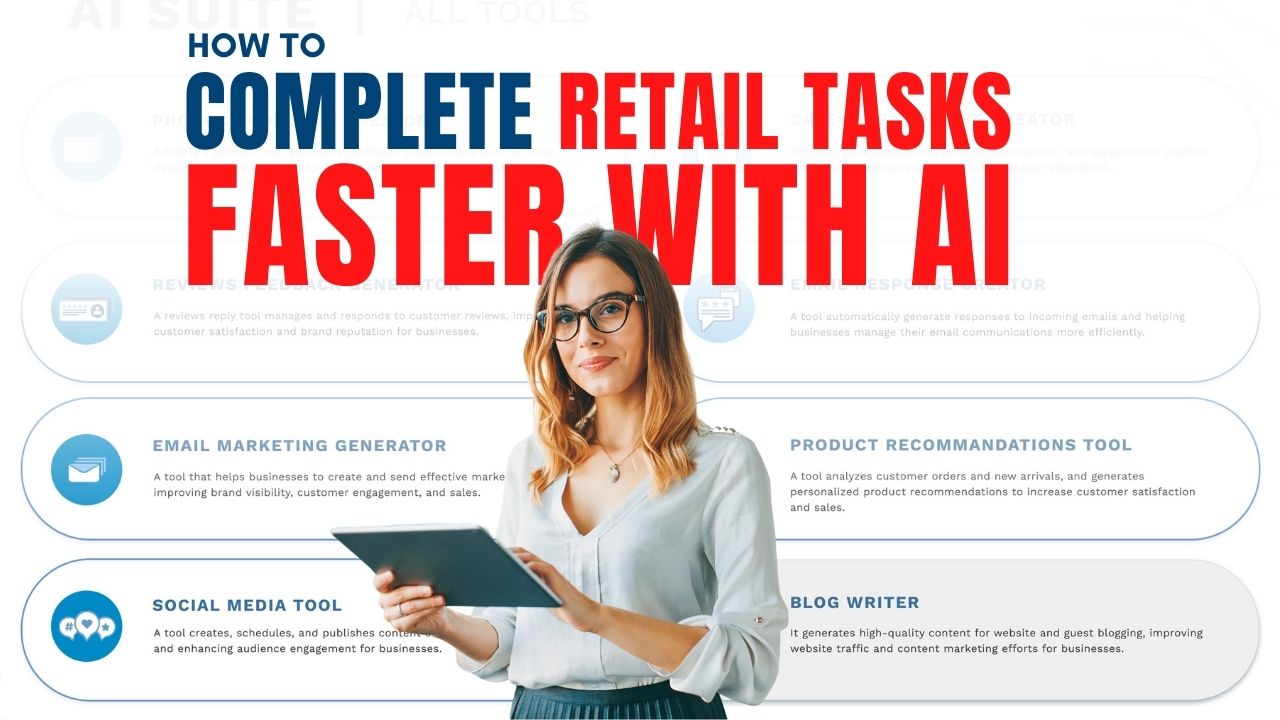Blog
How to Use AI in Retail to Complete Tasks Faster
March 1, 2024 / 8 minute read / By Nick Borowitz

Blog

Have you thought about how one day, you’ll be able to use machine learning to automate tasks in your retail business? AI is definitely not anything brand new; in fact it’s been around for years—but these days it seems to be all anyone is talking about.
But how can retailers actually leverage AI to help save time and get their every day tasks completed with less effort? What aspects of AI are really tangible and can help a retailer now—while also being cost effective and sensible for a small to mid-sized retailer? With AI, retailers can absolutely execute tasks faster, with significantly less effort. This means saving money and having more time to focus on other business aspects.
We’ll explore how you as a retailer can use AI to simplify time-intensive tasks.
Writing content for retail business websites is challenging, both from a creative and technical aspect. On the technical end, you have factors like keywords and SEO visibility that need to be planned for. Engaging content, unique product descriptions and professional customer inquiry responses are difficult without a dedicated staff member.
Artificial intelligence is invaluable in this aspect as it can perform the tasks mentioned above instantaneously, leveraging machine learning to generate content based on a simple prompt.
Automation for content creation saves time in retail, but it’s crucial to remember that AI’s learning process is evolving. AI-generated content may occasionally not make the most sense, underscoring the need for thorough editing and proofreading to maintain clarity. The goal for AI should never be to replace the human element, but moreso to expedite the process, with someone reviewing and tweaking as needed. The AI will only keep getting smarter the more you work with it as well.
Maintaining competitive pricing is a challenge requiring time and research. This includes what the competition is selling at, logistics and product availability, sales forecasting, and more.
By using AI business intelligence software, these tasks can be automated to generate optimal pricing that retailers should use, which then ensures profit optimization.
Improving website navigation for customers can be challenging without a logical layout. Manual mappings and redirects can also complicate this or cause the search function to fail.
Integrating AI in eCommerce product searches streamlines navigation. This saves time on manual redirects and offers better recommendations. Predictive site searches instantly suggest products as the customer types, showing similar items with images, colors, sizes, and attributes.
Ultimately, the goal here is to use AI retail tools to help customers find the products on your website faster, by using a set of AI logic to predict the products they are looking for, before they even finish typing the entire product into the search box. Suggested products appear right beneath the search box, with images and product information to help the customer access specific product pages faster.
Then, when the customer is on that product page, the AI retail tools will continue to show recommended products as well, lower on the page. This recommendation process considers factors like previous search history (both for that customer and other customers), seasonality, and purchases, guiding customers to new product pages and encouraging additional purchases. Navigation through AI integration increases customer engagement, higher conversion rates, and improved user experience.
To implement AI for eCommerce product searches, keep current mappings and redirects. As the system learns, these settings can be phased out. Retailers can opt for AI to automatically update search fields or, like dynamic pricing, limit to recommendations.
Consumers—and many business owners—are still wary of facial recognition in retail, and that’s okay. When retailers use it to make in-store processes easier, it can begin to favorably change the mind of the consumer. It can actually be a huge help for both customers and employees.
Let’s take a quick look at some of the new, AI facial recognition methods that might be considered:
The practical applications for making in-store experiences better with artificial intelligence are endless. From expedited check-ins to self-service kiosks and heightened security measures, facial recognition stands as a valuable asset benefiting both customers and employees alike.
We’re going to briefly change gears to wrap up this AI blog and highlight that everything above will soon be available to our retailers, here at Celerant!
Celerant is currently in the process of developing the technology that will help retailers and other businesses thrive in this new digital era. These retailer AI projects have been in development by our team for well over a year and we are looking forward to continuing to evolve them as we move forward.
Here are more ways in which we will be helping our retailers using AI in the future:
Perhaps the most important note when it comes to AI strategies: Our goal is to never eliminate human interaction. One of our differentiators at Celerant is the relationships that our team develops with our retailers and partners.
Our Celerant team will always be accessible and will always offer personalized telephone support, but our automated AI tools could soon help you get to the root of the inquiry and tell us what we need to do to reach the resolution much faster. The ultimate goal is to save you time, by saving our team time—it’s a win/win for everyone.
Artificial Intelligence is already influencing the retail industry in different ways. As outlined above, these are a FEW of the avenues where the impact will be invaluable, and those tools will help retailers save time and money. As it continues to evolve, AI will become smarter and able to perform more tasks.
As a POS system provider with more than 20 years of experience, we’re excited for what is to come.
We also ask you “Will you be ready for AI to change the way you do business?”